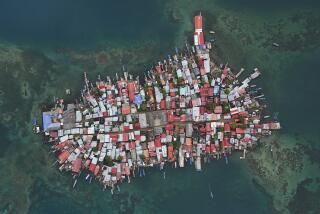Rising Oceans Could Doom Maldives Islands
MALE, The Maldives — Global warming is the stuff of seminars elsewhere, but not here. On this chain of coral islands and sandy beaches, it may spell doom.
Eighty percent of this archipelago stretching across the equator--a favorite hangout of European sun worshipers--could disappear if the Indian Ocean rises by 20 inches.
That’s not unlikely, say some scientists.
The sea level already has risen by 1.4 inches in 25 years, according to Australian researchers. Within 100 years, most of The Maldives could be a mariner’s memory.
In all the 1,191 Maldivian islands and islets, not one rises higher than 6 feet above the sea. They are fortunate to be set in normally calm seas.
A U.N. scientific panel has predicted sea-level rises worldwide of up to 3 feet in the coming century, because an atmosphere warmed by the greenhouse effect--the trapping of Earth’s heat by carbon dioxide emissions--will transfer heat to the oceans, which expand as they warm.
At the Antarctic Research Center in Hobart, Australia, researchers tested ocean water as deep as 2,950 feet and found that it had warmed by 1 degree Fahrenheit from 1962 to 1987.
In these islands of coconut trees, fishermen’s thatched huts and tourist hotels, where the population of a quarter of a million manages with just a few hundred cars, people blame factory emissions and motor exhausts thousands of miles away for the peril they face.
They fear the greenhouse effect also could change ocean currents and generate more storms.
“Any one of these changes will be a threat,” said Abdul Rasheed Hussain, planning and environment minister. “These are delicate islands, protected by a delicate coral reef. If the pattern changes, we don’t know where we will be.”
The Maldives woke up to the danger in 1987 when one-third of the nation was suddenly flooded. “It was a clear sunny day, and all of a sudden there was this wall of water,” Hussain recalled.
There were no deaths, but property on the sea front of Male, the capital, was washed away.
The government has banned dropping anchor on the coral reefs--the only natural barrier--to protect them from damage that would grow worse with wave erosion. It also outlawed harvesting coral, used for jewelry and building material.
But The Maldives, a nation with a per capita annual income of $800, can do little to protect itself, or even to monitor and analyze data from tides and sea levels.
Japanese aid helped build a 20-foot-high wall of concrete blocks off Male island’s eastern shore, to protect against tidal waves. But the cost--$4,700 per foot--is prohibitive for protecting 200 inhabited islands.
More to Read
Sign up for Essential California
The most important California stories and recommendations in your inbox every morning.
You may occasionally receive promotional content from the Los Angeles Times.










